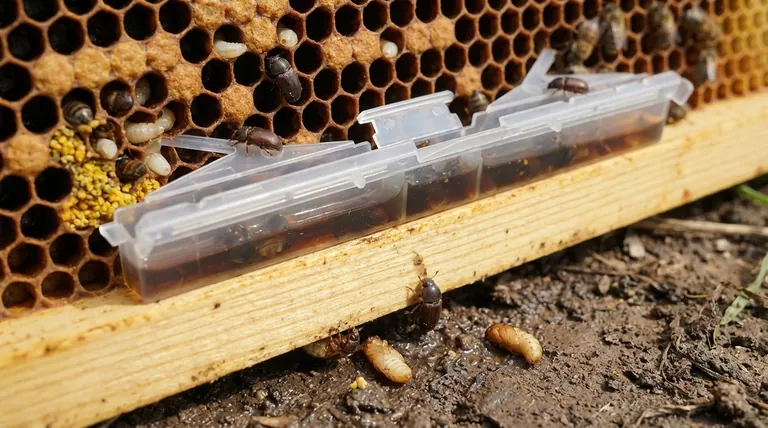The small hive beetle life cycle consists of four distinct stages: egg, larva, pupa, and adult. The entire process from egg to emerging adult typically takes 4 to 8 weeks, with the majority of that time spent pupating in the soil outside the hive. This two-location cycle, both inside the hive and in the surrounding ground, is the most critical factor in managing this pest.
The most crucial takeaway for any beekeeper is that controlling small hive beetles requires a two-front strategy. You must address the larvae inside the hive and simultaneously target the pupae developing in the soil outside of it to effectively break their life cycle.

The Four Stages of the Small Hive Beetle Life Cycle
Understanding the timeline and location of each stage reveals the pest's vulnerabilities. The beetle cannot complete its development without access to both the hive's resources and the nearby soil.
Stage 1: The Egg
Female beetles lay clusters of eggs in the cracks and crevices of the hive, away from the sight of worker bees. These eggs are small and pearly white.
Under typical hive conditions, the eggs hatch in just 2 to 4 days, quickly releasing the destructive larval stage.
Stage 2: The Larva (The Destructive Phase)
The larvae, which resemble small white grubs, immediately begin to feed on the hive's resources, including pollen, honey, and sometimes bee brood. This feeding period lasts for 7 to 10 days.
It is the larval stage that causes the most direct damage. Their burrowing and excretions cause the honey to ferment and spoil, creating a slimy mess that can drive bees to abscond from the hive.
Stage 3: The Pupa (The Hidden Threat)
Once the larvae have fed sufficiently, they perform a crucial migration. They crawl out of the hive entrance and burrow into the top few inches of the surrounding soil to pupate.
This pupal stage is the longest part of the beetle's development, lasting 3 to 6 weeks. During this time, they are hidden underground, transforming from larvae into adult beetles.
Stage 4: The Adult (The Reproductive Engine)
Newly emerged adult beetles are strong fliers and can detect a hive's odor from a significant distance, allowing them to find new colonies to infest.
An adult small hive beetle can live for approximately 6 months, and a single female is capable of laying up to 1,000 eggs in her lifetime, ensuring the potential for rapid population growth.
Key Vulnerabilities in the SHB Life Cycle
An effective management strategy targets the weakest points in this cycle. The beetle's need to transition between the hive and the soil creates two primary opportunities for intervention.
In-Hive Vulnerability: The Larval Migration
Before leaving the hive to pupate, the mature larvae must crawl across the bottom board and out the entrance. This predictable movement makes them susceptible to in-hive traps.
Traps placed on the bottom board can capture a significant number of larvae, reducing the number of beetles that will eventually pupate and emerge as adults.
Out-of-Hive Vulnerability: The Pupal Stage
The beetle is arguably most vulnerable during the pupal stage because it is stationary and confined to the soil near the hive. It cannot complete its life cycle without this step.
Treating the ground around the apiary interrupts the cycle externally. This prevents the pupae from developing into adults and re-infesting the colony, breaking the cycle of infestation.
Applying This Knowledge for Hive Defense
By understanding this complete life cycle, you can move from a reactive to a proactive defense strategy.
- If your primary focus is preventing a new infestation: Maintain a strong, populous colony that can police beetles, and minimize cracks or crevices where adults can lay eggs.
- If your primary focus is managing an active infestation: Use a two-pronged approach of in-hive larval traps to catch the current generation and a soil treatment to eliminate the next generation during pupation.
Understanding the small hive beetle's full reproductive journey, both inside and outside the hive, is the definitive key to protecting your colonies.
Summary Table:
| Stage | Duration | Location | Key Activity |
|---|---|---|---|
| Egg | 2-4 days | Hive crevices | Laid by adult beetles |
| Larva | 7-10 days | Inside the hive | Feeds on pollen, honey, and brood |
| Pupa | 3-6 weeks | Soil outside hive | Transforms into adult beetle |
| Adult | Up to 6 months | Hive and flying | Lays up to 1,000 eggs |
Protect Your Apiary with the Right Equipment
Now that you understand the small hive beetle's life cycle, you know that effective control requires a two-pronged strategy targeting both the hive interior and the surrounding soil. HONESTBEE supplies the durable, effective beekeeping supplies and equipment that commercial apiaries and distributors need to implement this defense.
We provide wholesale-focused solutions to help you manage pests and maintain healthy colonies.
Ready to strengthen your hive defense? Contact our team today to discuss your specific needs and our range of products.
Visual Guide

Related Products
- Reusable Clear Small Hive Beetle Traps for Beehives Beetle Trapping Tools
- Removable Washable Hive Beetle Trap Attractants for Small Hive Beetles
- Black Plastic Beetle Barn Hive Beetle Trap for Beehives
- Plastic Beetle Blaster Trap Beekeeping Tools and Supplies
- Gourd Shaped Hanging Wasp Trap Professional Wasp Catcher
People Also Ask
- How do Beetle Blasters trap adult beetles? A Simple, Non-Chemical Pest Control Solution
- What tips can help prevent hive beetle infestations? Build Strong Colonies & Master Apiary Hygiene
- What are the steps for installing hive beetle traps? A Guide to Effective Beetle Control
- Why are hive beetle traps important for beekeepers? Protect Your Hive from a Devastating Infestation
- How do hive beetle traps work? A Beekeeper's Guide to Non-Chemical Control



















